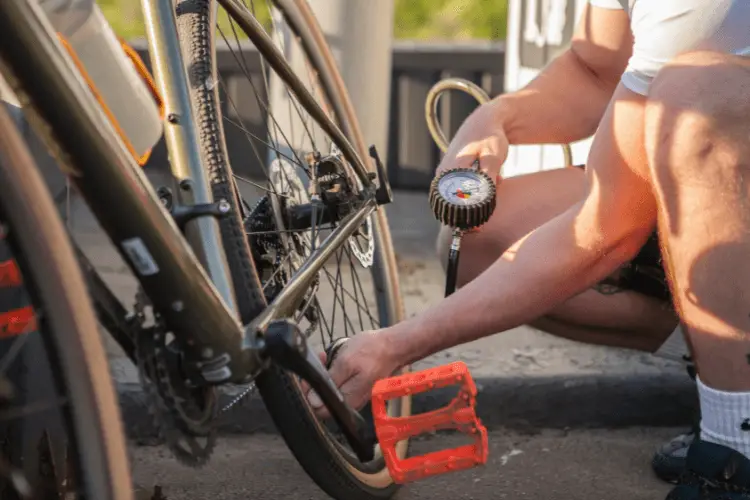Bike tire liners are worth it. They increase your tire weight and offer better protection against punctures when you’re riding without them. They are not cheap, which shows the quality they offer.
If you suffer punctures regularly while you ride because of bad roads, foreign objects on the road, or goatherds, then you should consider getting bike tire liners.
When thinking of road hazards while riding, you’ll probably think of bumps, potholes, or maybe cars.
However, there are a few hazards that can be lurking on the surface of the road. These hazards can cause damage to your tires as well. This is where bike tire liners come in.
In this article, we would talk about the different types of bike tire liners, how good they are, and what other alternatives you can select.
Quick Navigation
Are Bike Tire Liners Necessary?
Yes, they’re necessary to give bike tires protection. Thorns, shattered glass, or rusty nails can cause serious damage to your tires and they may not be repairable by sealant or tire patch. This is where the tire liner becomes important.

Bike tire liners are necessary. But many riders complain that they’re expensive or add unnecessary weight to your bike tires making it not worth it.
- But that is not true because bike tire liners offer protection against punctures more than when you’re riding without them.
- While riding on the road or mountain trail, you can easily get a flat tire. Bike tire liners won’t make your bike tires invincible against these.
- They will also provide your tires with an extra layer of protection against foreign objects that are thin and sharp.
Those who are skeptical about bike tire liners, know that they can be the difference between having a pleasant ride and walking a mile with your bike by your side.
Recommended Bike Tire Liner
- Lightweight-Weighs less than liquid fills and thorn-resistant tubes
- Easy installation-no gooey mess
- Absolutely, positively, will not cause tire or tube to damage or loosen spokes
- Eco-friendly and reusable from bike to bike and biodegradable when disposed
How Do Bike Tire Liners Work?
Bike tire liners cover the space between the tire’s tubes and the inside of the tire. Since they cover all sides of the tire, they don’t let the tire tube get punctured by any means.
Bike tire liners are strips of durable, sturdy material placed between the tire’s inner tube and the tire’s interiors.
Your tires don’t become puncture-proof when they’re covered by the liners. Instead, the tire liner functions as a shield between whatever wants to penetrate the tire rubber and get to your tube.
This means the tire liners are there to receive all the pressure from foreign materials lined on the mountain trails or roads and stop them from reaching the tube.
This goes without saying that bike tire liners won’t stop the tires from sidewall punctures.
They also don’t stop the tire from going flat. So ensure to check your tires and their pressure before riding out with low pressure.
How Good Are Tire Liners?
Bike tire liners are very good and function properly when adequately arranged inside your tire surface. If you live in an area with road debris or lots of sharp objects on the road, then the liner is your best bet.

Bike tire liners function very well and are popular. They add weight to your tires which you will notice in your rolling resistance when you ride with high-performance tires.
While they protect the tire from external penetration, they have no control against internal damage.
They may not guard against dead-on-hit nails but they can divert the effect of a sharp hit to prevent a flat tire.
Tire liners are not perfect because they vary in quality based on the brand.
However, they’re very good for protection but you need to pick the ones that suit your riding conditions.
How Good Are Anti-Puncture Tire Liners?
Anti-puncture tires perform considerably well in their functions. These tires have a few large threads that are surrounded by many rubber compounds which makes them highly puncture-resistant.
The anti-puncture tire performs just as the name suggests. If you observe these tires after riding for a while, you will find out that they don’t have many puncture lines.
This is because the tires are built with tough materials which give sharp objects less chance of piercing the inner tube. They also last longer in terms of use due to these same materials.
They also offer good value for money. They are not too costly to buy because the tough compounds used to make them are cheaper than those used in making racing tires.
Do Mr. Tuffy Tire Liners Work?
Yes, they do. They increase protection when used to shield the inner tube from puncture. They’re quite lighter than puncture-resistant inner tubes and quite effective against any road hazard.
Me Tuffy Tire Liners are :
- Reusable polyurethane strips that form a protective barrier on the inside of your tires.
- Preventing inner tube punctures caused by sharp objects and offering protection to the tire.
Compared with self-sealing and thorn-resistant inner tubes, Mr. Tuffy liners are :
- Lighter,
- More effective, and
- Easy to install.
This tire liner is made of urethane which makes it elastic and hard against any sharp objects. Due to its two-layer tuff, this liner has a better shield against puncture.
If you’re considering getting this liner, you should go for it because it will offer you value for your money.
Types of Bike Tire Liner
There are different types of bike tire liners because of the quality used in making them. Each of them is different and has its advantages and disadvantages.
Let’s look at some of them and you can choose the best for your bike.
1. Rim Liners
The rim liners are tiny strips of plastic that protect the inner tube from puncture by the spoke especially as the spoke makes some movement due to the weight it absorbs from the bike, rider, and road hazards.
Rim liners do not have to be puncture resistant or strong so they sell fast due to their cheap cost.
When you get the rim liner, ensure it aligns correctly and does not overlap with itself, or else it will create friction that will damage the tube.
2. Anti-puncture Liners
Anti-puncture liners are positioned between the interior of the tire and the inner tube. They function as a shield against foreign objects.
They work very well against small and thin objects but will not function well against a large nail or big piece of broken glass.
3. Low-End Liners
These are the commonly used bike tire liners. They’re made with polyurethane and come in a large enough roll to cover two tires.
Due to the lack of a peel-and-stick, you might find them hard to properly align. This can bring issues with overlapping ends, kinks, wrinkles, or the falling off of the crown center.
All these can cause serious damage to your tires. However, they don’t add much weight to your tire and are inexpensive.
Bike Tire Liners Alternatives
(i) Tire Sealant
These are slime sealants that can perform more than tire liners because of how far they can reach.
These sealants fill the smaller holes and prevent leakages that debris that pass your liner can cause.
(ii) Puncture Resistant Tires
These times come with an extra layer of material that protects the inner tube. They can handle a lot of debris and can stop debris more than liners at times but they’re expensive.
(iii) Tubeless Tires
Tubeless tires are the hardest alternative here. They’re covered by sealants that reduce weight, plug holes, and manage rolling resistance better than some protection alternatives but they’re expensive.
Final Thoughts
Are tire liners worth using to prevent punctures? Yes, they are.
You should consider getting them for your bike because they’re important to providing protection but your bike tire would become heavier and they’re quite expensive.
- Lightweight-Weighs less than liquid fills and thorn-resistant tubes
- Easy installation-no gooey mess
- Absolutely, positively, will not cause tire or tube to damage or loosen spokes
- Eco-friendly and reusable from bike to bike and biodegradable when disposed



